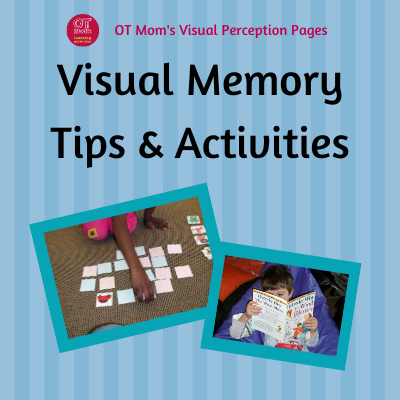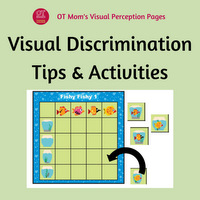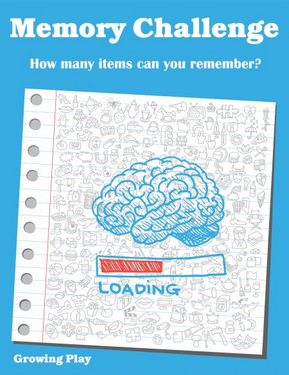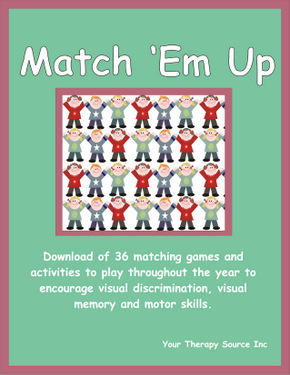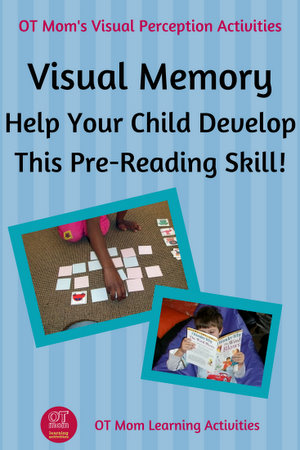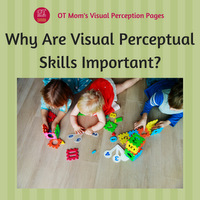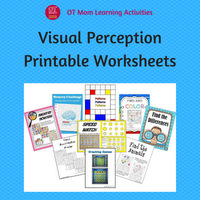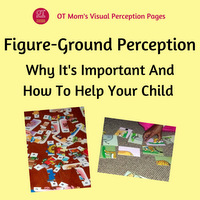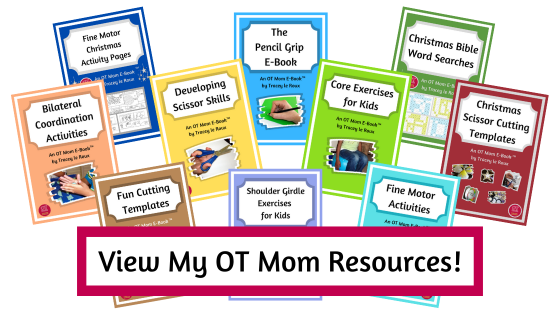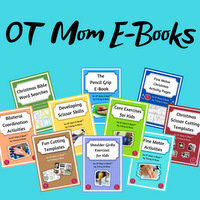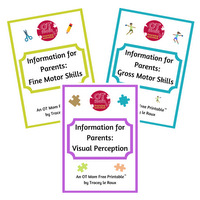- Home Page
- Visual Perception Activities
- Visual Memory Activities
Visual Memory Activities:
Fun Games To Boost Your Child's Reading Skills
These simple Visual Memory Activities can help your child master reading and writing!
Does your child struggle to recognize letters and remember sight words? Is copying from the board a laborious process? You are not alone! Try these simple, playful activities to strengthen your child's visual memory skills and boost their confidence in learning!
I sometimes link to products (#Ad) that are similar to those I use and love. If you do purchase something through my links, I will receive a small commission that helps support my site - thank you!
Key Takeaways For Busy Parents:
- Visual memory is important for reading, writing, recognizing numbers and remembering sight words.
- Use games like Concentration and Kim's Game to help improve visual memory skills - adjust the difficulty according to your child's age and ability.
- Try these easy, hands-on visual memory exercises and printable visual memory activities at home.
- Seek professional advice if your child struggles.
These visual perception activities are intended to encourage your child's normal visual perceptual development.
If you suspect your child has visual perceptual delays, please seek a professional opinion.
What Is Visual Memory And Why Is It Important?
The ability to recall or remember the visual details of what you have seen is known as visual memory.
Remembering faces, sight words, and the appearance of a building you have only seen once, are all examples of using visual memory skills.
The ability to learn sight words is particularly dependent on visual memory skills.
Children with poor visual memory skills may struggle to:
- recognize numbers and letters
- remember sight words
- copy work from the board or a book, as they struggle to remember what they saw on the board and have to keep checking back
It is therefore really important for children to have lots of opportunities to develop their visual memory skills, and the activities on this page are suitable for preschool age and older.
Visual memory activities can often be seamlessly adapted to demand visual sequential memory skills as well, so I link to my visual sequential memory page as well, to show you how to do this.
For your convenience, I have linked to products on Amazon #Ad similar to the ones I use. I may earn a small commission if you purchase something through my links.
How To Improve Visual Memory:
- Play Concentration/Memory Games
You can use any sets of matching cards to play Concentration Game or Memory Game#Ad.
Cards with bright, clear, uncluttered pictures
are the easiest ones to start with.
The idea is that you turn the cards face down, mix them up. Then each player takes a turn turning over two cards at a time. When you get a matching pair, you can keep them.
The memory aspect comes in when you remember where the matching card is that someone turned over earlier.
Upgrade to cards with more details or abstract designs for older children or kids who need more of a challenge.
I usually start with a set of 6-8 pairs and gradually increase the number of pairs used in the game as the child’s visual memory improves.
Playing with a parent or a sympathetic older child is best, as they can usually "lose" gracefully in order to boost your child's confidence.
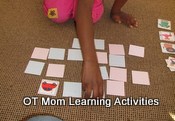 Playing "Concentration"
Playing "Concentration" You can adapt this activity to boost visual sequential memory skills too!
- Play Kim's Game
Kim's Game is a well known Boy Scouts game which is used to develop the scout’s ability to notice details and recall what was seen. I use simple adaptations of this game as effective visual memory activities.
You will need a plain tray, a variety of household objects and/or small toys, and a cloth to cover the items.
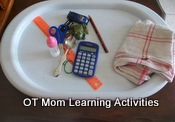 A variety of household items
A variety of household itemsVery Important:
Make sure your child knows the names of all the objects you will use in Kim's Game. You can adapt the game according to the age and ability of your child by altering the number of objects shown and/or the time given to look at them!
If your child struggles with verbal skills, then have a duplicate set of items, with some additional objects, on the side, and your child can point out the ones seen on the tray. So if you have 4 objects on the tray, have the same four on the side, with 4 or 5 extra objects to muddy the waters a little :-)
These are the basic steps for playing Kim's Game:
1) Without your child seeing the items, place a few items on the tray, and cover them up with a cloth.
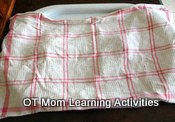 Cover a few items with a cloth
Cover a few items with a cloth2) Remove the cover and let your child take a look at the tray for a few seconds (5-10 seconds depending on the age of the child and the number of items).
Try to discourage your child from saying the names of the objects out loud, as this can trigger an auditory memory response instead of visual memory.
3) Cover the tray again and ask your child to name the objects that were on the tray.
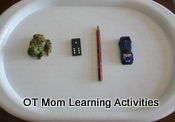 Reveal the items for a few seconds
Reveal the items for a few seconds Can your child remember what they saw?
Can your child remember what they saw?Variations on Kim's Game
- Instead of asking your child to name the objects seen, secretly take away one object, uncover the tray again and ask your child to tell you what object was removed.
- This is harder when the objects on the tray have been rearranged as well (you can rearrange the objects under cover of the cloth!).
- Using more objects adds to the difficulty...and it also gives you the option of taking away 2 or 3 objects and asking your child what is missing.
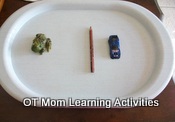 Which item is missing?
Which item is missing?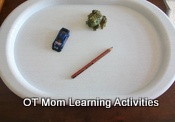 Rearrange the items to increase challenge
Rearrange the items to increase challenge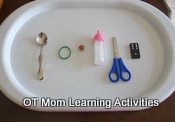 Add more items to increase the challenge
Add more items to increase the challenge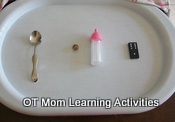 Take away more than one item - can your child tell you what is missing?
Take away more than one item - can your child tell you what is missing?Find out how to adapt Kim's Game to also work on visual sequential memory skills...
Helping Kids Who Struggle To Remember Numbers and Letters
I have often worked with children who had a hard time remembering what numbers looked like, even though they had a good grasp of number concepts and could count correctly.
- I used a variety of visual memory activities with them, and this helped them to remember what numbers, and ultimately letters, looked like.
- I also worked on visual discrimination skills to help kids see the difference between the numbers, and I used visual sequential memory activities as well.
An occupational therapist is able to assess children to try and understand why they may be struggling with school skills. So if you are at all concerned about your child's memory skills, please seek a professional opinion.
Printable Visual Memory Activities
There are a few printable working memory games that I used to help improve visual memory skills with my own kids at home as well as in a therapy setting.
Click on the images to view the downloads that were created by Your Therapy Source!
These visual memory activities are designed to be simple and easy to incorporate into your child's playtime.
Regular engagement can help boost their readiness for reading and writing - try and start with one game this week! .
Sign up for my free, occasional newsletter to keep in touch with new pages and resources when they become available - and get some free information downloads!
- Home Page
- Visual Perception Activities
- Visual Memory Activities
Share this page to help others!
Related Pages
If you want more information on visual perception and some additional activity ideas, then visit these pages on my site:
Didn't find what you were looking for? Try a search of my site!
